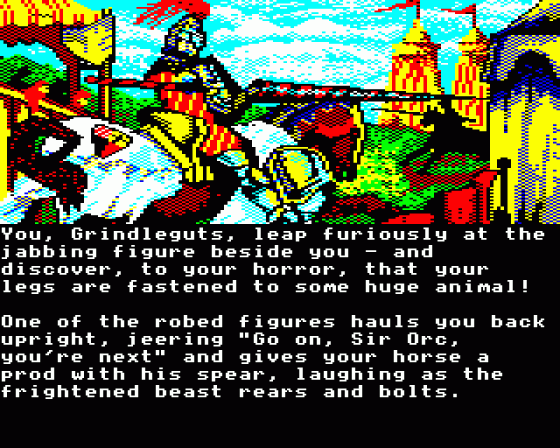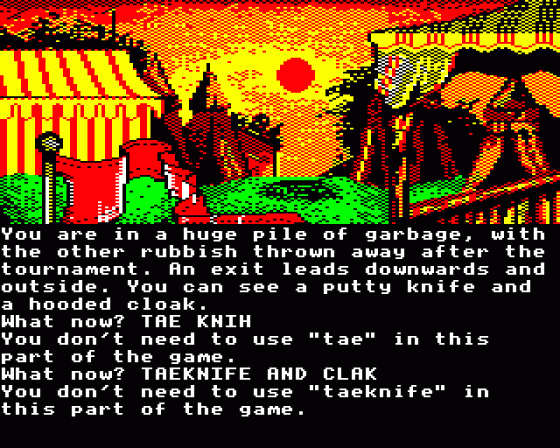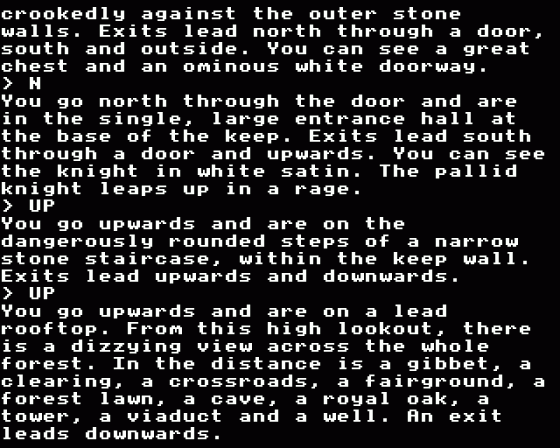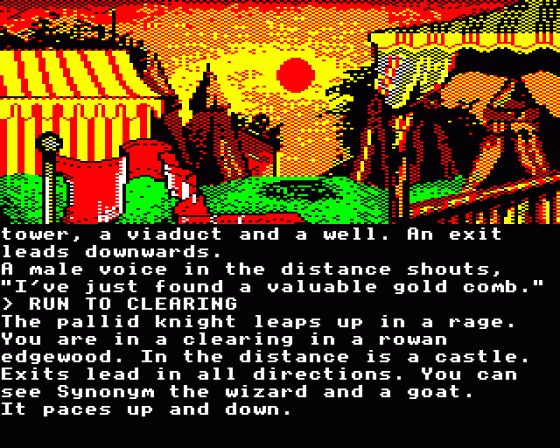




| Genre: | Adventure Game: Text-Only |
| Publisher: | Rainbird |
| Cover Art Language: | English |
| Machine Compatibility: | BBC Model B, BBC Model B+, BBC Master 128 |
| Release: | Professionally released on 5.25" Disc |
| Available For: | Amiga 500, Amstrad 6128, Amstrad CPC464, Atari 400/800/600XL/800XL/130XE, Atari 800/XE/XL, Atari ST, BBC B/B+/Master 128, Commodore 64/128 & Spectrum 128K |
| Compatible Emulators: | BeebEm (PC (Windows)) PcBBC (PC (MS-DOS)) Model B Emulator (PC (Windows)) |
| Original Release Date: | 1st September 1987 |
| Original Release Price: | £15.99 |
| Market Valuation: | £46.49 (How Is This Calculated?) |
| Item Weight: | 64g |
| Box Type: | Cardboard Box (Decorative) |
| Author(s): | John Jones-Steele, Mike Austin, Nick Austin, Pete Austin & Mike Bryant |
Variant Items
There are 0 other items featuring this same game (that we know about!). Click any of them for their details.
Active Auctions
Closed Auctions
Buy It
Unfortunately no-one is currently selling this item.
Auction Price Watch
Worried you're being ripped off? Closing prices on eBay can help you decide what a reasonable price is for a particular item.

Computer & Video Games
1st September 1987
Here is an adventure that is like nothing you've ever played before! Read Review
Full Instructions
Introduction
In a hole in a mound there lived an orc. Not a clear, dry sandy hole with only spiders to catch and eat, nor yet a comfortable hobbit-hole. It was an orc-hole, and that means a dirty, clammy. wet hole filled with bits of worms and a putrid smell.
It had a perfectly round garbage heap, blocking the doorway, with a slimy yellow blob in the exact middle for spitting practice. The doorway opened onto a sewer-shaped hall - a deeply unpleasant tunnel filled with smoke, with secret panels, and floors snared and pitted, provided with treacherous chairs and lots and lots of booby traps - the orc was fond of visitors.
But what is an orc? Orcs are not seen much nowadays, since they are shy of human beings. They are a pungent people, little bigger than overweight elves, with the charisma of blow flies and the appetite of gannets. Orcs have little or no magic, except a rudimentary skill with knives and strangling cords and, in short, they are evil little pits.
This orc was unusually ugly, even for an orc. His name was Gringleguts.
Grindleguts had lived in the neighbourhood of The Mountain for about a year and most people considered him two steps lower than a tapeworm, not only because of the smell and the plague, but because he kept eating their household pets.
Knight Orc follows on from the events described in "The Sign of The Orc". Grindleguts has been volunteered as their champion by the other orcs, while in a drunken stupor, and tied to a horse so that he won't escape, or fall off, before the joust. Your first task, as the orc in question, is to live long enough to escape over the viaduct to Ore Mountain. Good luck, Grindleguts. You're going to need it...!
Game Instructions: Commands
Knight Orc understands a wide range of commands in plain English, from simple one or two word instructions up to complex multiple sentences. This chapter is split into sections describing ways in which to communicate with the program.
1. Movement
To move around The Land, use the following commands:
| Word | Abbrv. |
| NORTH | N |
| EAST | E |
| SOUTH | S |
| WEST | W |
| UP | U |
| INSIDE | IN |
| CLIMB | - |
| CROSS | - |
| NORTHEAST | NE |
| NORTHWEST | NW |
| SOUTHEAST | SE |
| SOUTHWEST | SW |
| DOWN | D |
| OUTSIDE | OUT |
| JUMP | - |
These commands take you to an adjacent location. Use the EXITS command if you want to know which directions are allowed (when EXITS lead in "all directions", this means the eight main compass directions: N. NE, E, SE, S, SW. W and NW).
To save time, and so you don't need to draw a map, Knight Orc provides the commands below:
FOLLOW [person]
(e.g. FOLLOW INNKEEPER). Try to stay close to someone, moving when they do. Other people can be ordered to follow you as well, see section 111. However, they can sometimes get left a little way behind, because even the most loyal follower will not obey you 100% of the time. Either wait for them, or command them to move to the destination with you following them.
GO TO [place]
(e.g. GO TO CASTLE or GO TO WELL). The program works out the sequence of short moves needed to reach your destination (e.g. OUT, NE, N. NE, IN) and carries them out.
RUN TO [place]
(e.g. RUN TO INN). This is like GO TO, but does not print the descriptions of the places you run through.
FIND [object]
(e.g. FIND GOAT). Again, this works like GO TO and takes you to the place where the object is. Note that you can FIND just about anything, including people, moving objects and things inside containers.
Of course, there is not much that the program can do if you try to FIND something that does not currently exist. Or if the way to your destination is blocked (for example, there is a Thorn Hedge around the tower). In such cases, the program does the best it can.
2. Actions
The majority of commands that you will use are actions, such as opening doors, stealing treasure and hitting dumb animals. Here are some examples:
GET THE KNIFE
Take a stabbing weapon for later use
EXAMINE KNIFE
Stare closely at a tin-plated object
TIE THE CORD TO THE ROPE
Fasten one thing to another
PUT MOUSE IN THE SACK
Best place for it, if you ask me
EAT THE RAT PIE
Delicious
REMOVE THE TETHER
Untie something or take it from a container
PUT KEY UNDER THE MAT
I bet you've always wanted to do this
WEAR THE HELMET
Avoid headaches later on
OPEN THE CHEST
There may be treasure inside it
KICK THE FROG
It's smaller than you
To save typing, commands can refer to more than one object, e.g:
EXAMINE THE HORSE, KNIGHT AND LANCE
TAKE THE CLOAK AND THE KNIFE
Knight Orc understands the following collective nouns: ALL, EVERYTHING, EVERYBODY, TREASURE, WEAPONS and CLOTHES
Thus, you can enter things like:
GIVE THE TREASURE TO THE INNKEEPER
TAKE ALL THE CLOTHES
EXAMINE EVERYBODY
Exceptions are also understood, for example:
TAKE EVERYTHING EXCEPT THE MAT
DROP ALL THE TREASURE BUT THE GOLD BRICK AND THE GOLD FISH
And you can refer to the last mentioned thing as HIM, HER or IT, e.g:
TAKE THE AXE
EXAMINE IT
THROW IT AT THE GREEN KNIGHT
STEAL THE COIN AND PUT IT IN THE BUCKET
You can type several commands on one line, using punctuation or AND to separate them if you like, though this is not usually needed, e.g:
N NE NE CROSS (Though RUN TO PLACE is better)
OPEN DOOR. GO IN AND TAKE EVERYTHING
Using the full range of command features allows you to enter near-English sentences of considerable complexity. More important, it means the game is more likely to understand what you mean.
3. Talking to Other Characters
Orcs are not known for their small-talk and much prefer action to words, especially when that action is mindless, violent and aimed at someone smaller than them. So conversation is limited in this game.
People can be asked about things, and a few of them may even answer you. One in particular is a mine of information. For example:
HERMIT, TELL ME ABOUT THE KNIFE
TROLL, TELL ME ABOUT THE RING
People can be commanded to do the same sort of thing that you can do yourself, using the full range of commands. Denzyl is the only person who will obey without being recruited and I leave it to you to work out how to make other people and creatures follow your commands. Remember that you can't finish the game without help. Example commands are:
DENZYL. FOLLOW ME
DENZYL. FIND THE WELL. TAKE EVERYTHING. FIND ME, GIVE EVERYTHING TO ME DRAGON, FLY SOUTH AND KILL GROK. THEN FOLLOW ME
In some other adventure games, when you give someone a command, they go off and do whatever It was while you have to stand there and wait. Knight Orc is somewhat more realistic.
If you tell Denzyl, "DENZYL, GET THE FISH, FIND ME AND GIVE THE FISH TO ME", he will head off to find it - moving roughly once for every move you make. Then you can get on with solving other puzzles, doing whatever you like, while Denzyl carries out his task. Eventually he will wander back and hand over the fish.
By the end of the game, you may well have acquired a lot of followers, and they can all be give orders to carry out at the same time. For example, if you want a simultaneous attack on the vampire. you might enter commands as follows:
TROLL, WAIT 2, IN, KILL VAMPIRE
MOUSE, WAIT 1, IN, KILL VAMPIRE
IN, KILL VAMPIRE
Needless to say, a lot of puzzles in the later stages of Knight Orc require co-operation between creatures.
4. High Level Commands
Knight Orc provides a number of powerful multi-stage commands, where you enter a single command such as "RUN TO THE TOWER" and the program carries it out in stages. The idea is that it is easier to enter one command that a lot of little ones.) Most of these have already been described above. and the full list is:
FOLLOW [creature]
Try to stay with someone. STOP FOLLOWING later.
GO TO [place]
Go to the place (the program works out the route).
RUN TO [place]
As "GO TO", without printing location descriptions.
FIND [object]
GO TO where an object is.
KILL [creature]
Hit and/or pursue creature in a fight-to-the-death.
WAIT FOR [creature]
Wait until the creature arrives.
WAIT FOR [number]
Wait for the specified number of 'turns'.
WAIT UNTIL [time]
(Use the TIME command to learn the current time).
If something unforseen happens, these commands can be paused by pressing SPACE. The program will ask if you want to continue: Press Y or N for yes or no.
5. Magic
Magic works in the Knight Orc world and there are twenty-one spells to learn. You'll be able to learn them in later stages of the game and will have to know every spell in order to finish.
To learn spell, you just need to see or hear its name. To use it, once learr enter CAST [spellname], or CAST [spellname] AT [target]. E.g:
CAST GLOW
CAST FIREBALL AT DRAGON
CAST LOCATE AT RING
The functions of the spells are fairly obvious from their names and the rest is up to you!
6. Special Commands
Knight Orc provides a number of general purpose commands:
INVENTORY (INV)
What are you carrying? (Try EXAMINE ME, too.)
SCORE
How badly are you doing?
AGAIN (A)
Repeat the last command
HELP
This sometimes gives you a clue.
QUIT
Stop the game.
BRIEF
Don't report unnecessary text, e.g: exits and shouting.
VERBOSE
Report text in full.
Several commands are provided to control the adventure system, rather than to make progress in solving the game, and these are described below.
Please note that some of these facilities marked with an asterisk are not provided on some smaller computers and that the best way to find if a command is preesent in the version of Knight Orc for your micro, is to try it.
WORDS
Turn off the pictures.
PICTURES
Turn them back on again.
OOPS
Restore the position as it was before you last moved. OOPS (or UNDO) is a very useful comand and, on larger machines, it can be used several times in succession to step backwards through the game.
SAVE
Stores the game position on cassette or disc. Insert a formatted disc, or start a blank cassette before using this command. (Commodore 64 users may specify whether to save to cassette or disc by adding .1 to the filename for tape, or .8 for disc). When the SAVE has finished, stop the tape, or replace the Knight Orc game disc in the drive, as appropriate.
RESTORE
Loads a previously SAVED position from cassette or disc. Enter RESTORE and then answer YES as confirmation. To restore from tape, rewind the cassette on which the position was SAVEd and start it on PLAY (if the cassette doesn't move, press ENTER or RETURN). To restore from disc, put the disc on which the position was saved in the drive, before using RESTORE. If you are asked for a filename or equivalent, enter whatever you called the position when it was SAVEd. When the RESTORE has finished, stop the tape, or replace the Knight Orc disc in the drive, as appropriate.
RAM SAVE
Saves the game position in memory. This is quicker than saving on tape or disc, but the data is not as permanent and will be lost if the computer is turned off or reset.
RAM RESTORE
Loads a previously RAM SAVEd position.
Note: OOPS, SAVE, RESTORE, RAM SAVE and RAM RESTORE can also be entered in response to a YES/NO question. For example, if you have just been killed in the game and the program is asking if you want to play again, you can use one of them to return to a previous position instead.
Picture Moving
On computers such as the Amiga, Macintosh, and Atari ST, the mouse can be used to move the picture up and down - allowing you to choose how much text is visible below it. Disc versions on some other computers, e.g the Commodore 64, control this feature by means of the up and down cursor (arrow) keys.
Command Editor
Some of the machines with larger memories provide a command line editor which keeps a copy of your previous commands and lets you edit and re-enter them. The command editor is controlled by the cursor keys, delete and backspace, and works in insert mode. Press cursor-up to display your previous commands: the other details are best learnt by trying it.
Game Details
Knight Orc is a single game, with three sections, and you must start with part one. Loosed Ore, and solve this before proceeding. The computer will display instructions on how to do this, when the time comes.
Parts two and three, A Kind of Magic and Hordes of the Mountain King, are linked together, and you can move freely from one to the other.
Scoring
Loosed Orc:
The idea is to learn the adventure system and tie ropes together to make a single rope, long enough to use in crossing the chasm. You score points according to its size.
A Kind of Magic and Hordes of the Mountain King:
Learn magic, recruit followers and escape. You score points for each spell learnt, each follower recruited (providing they have powers which complement, rather than duplicate your own), plus bonuses for solving the final stage of the game.
Hints
When adventurers recognise an orc, they attack.
You are not likely to win many fair fights. Why not run away, or distract your opponent, or cheat in some other way.
You can't take it with you (usually). so it's better to be poor than dead.
Loading
Tape: CHAIN"" (RETURN)
Disc: SHIFT-BREAK
Remember to always have a blank cassette or a formatted disc at hand to save your game position on. See section 6 of Game Instructions for more information about saving and restoring your game position. Each version of Knight Orc has a Menu program, which will instruct you in the further loading of the game (if necessary). Simply refer to the table below, and select the appropriate loading instructions:
Game Credits
Idea, design and text: Pete Austin
Game programming: Mike Austin
Adventure System: Mike and Nick Austin and John Jones Steele
Map and Testing: Andrew Deeley
Testing: Paul Coppins
Original Painting: Godfrey Dowson
Additional artwork: Neil Studwick and Stuart Lee
Poster: Paul Human
With thanks to all at Rainbird (and the Dragon, Mouse and Troll) without whom this game could not have been completed.
Screen Designers
The following utilities are also available to allow you to edit the supplied screens of this game:
Cheats
Download
A digital version of this item can be downloaded right here at Everygamegoing (All our downloads are in .zip format).
| Download | What It Contains |
|---|---|
| A digital version of Knight Orc suitable for BeebEm (PC (Windows)), PcBBC (PC (MS-DOS)), Model B Emulator (PC (Windows)) |
Report A Problem
We thank you from the bottom of our hearts if you report something wrong on our site. It's the only way we can fix any problems!
You are not currently logged in so your report will be anonymous.
Add Note
Release Country
Change the country to update it. Click outside of this pop-up to cancel.
Scan Of Selected Article
If you auction an item, it will no longer show in the regular shop section of the site.






